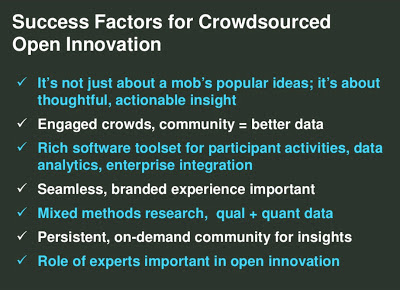“Participation is the new brand.” – Chaordix
“The future of organisations is bringing chaos and order together” – Dee Hock (founder of VISA)
In the world of marketing, crowds have always been a major fascination. We love to see crowds, especially during product launches or events. A well visited website is a good website – especially if its for the right reasons. Unfortunately, few of us have harnessed the true power of crowds.
Seeking to change that, Shelley Kuipers of Chaordix shared at the recent Crowdsourcing Week in Singapore that companies should work closely with their customers to crowdsource market insights. Putting in place the right structures and mechanisms, they can form brand loyalty groups out of their Facebook fans/ Twitter followers.
The most enthusiastic and knowledgeable can even be brand prosumers, lending their collective wisdom to co-create disruptive innovations. Prosumers are very active participants who work proactively for you and your brand.
To succeed in this space, 7 factors are needed as outlined in the slide below:

Courtesy of Chaordix
1) Seamless branded experience is about providing an end-to-end holistic experience which resonates with your brand values. It is ensuring that the little things matters as much as the large ones, encompassing all touch points.
2) Thoughtful, actionable insight is about purposefully channeling the crowd’s views and wishes towards a clear and defined end. It isn’t about just catering to the whims and fancies of the mob!
3) Engaged crowds that form communities of interest usually provide better data to market researchers.
4) Like in all things, market research is best done integrating online and offline observations and data.
5) To reap a continuous flow of actionable insights, it is useful to have a persistent, on-demand community which you can tap on.
6) As I’ve highlighted, experts like prosumers can play the role of brand and product innovators. A case in point is LEGO’s CUUSOO platform (go check it out).
7) Rich software tool-sets are useful to manage participant activities, conduct data analytics and integrate these insights with the enterprise’s activities.
Bringing these suggestions to life are two case studies from Shelley’s work.
The first is a Consumer Packaged Goods (CPG) Marketing Innovation Fund at P&G. Known as the CMK (Consumer Market Knowledge) Innovation Fund Challenge, this crowdsourced platform seeks innovation from the public on the development of new products from the global FMCG behemoth.
The second example is American Airlines. Working with Future Brands, Chaordix helped the airline to design a one time programme encouraging customers and employees to participate globally in a “crowd branding” initiative through incentives and gamification. (You can find more interesting examples of crowdsourcing by major airlines in this article.)
For the road ahead, companies can consider new ways to catalyse brand and product innovation, leveraging on the “wisdom of their crowds”. These are highlighted in the slides below:
.bmp)
Courtesy of Chaordix
To “co-mingle” peer brand crowds, companies could consider bringing together customers of complementary brands to exchange knowledge and information. For example, customers of smartphone, digital camera and tablets are likely to have similar interests. The cultivation of prosumer talent pools (engaged and involved alpha customers) require a more proactive recruitment strategy. Often these customers could be identified through social media intelligence.
Mobile apps present excellent opportunities for research, due to their ability to provide real-time customer feedback while initiatives like sponsorship programmes and micro-funding competitions spur greater customer innovation. Finally, pre-buy innovation communities like Kickstarter look like they’re here to stay.
Are there other ways in which marketers can work with crowds? How else can we draw them into our organisations?
For more, check out Shelley’s full set of slides below:
